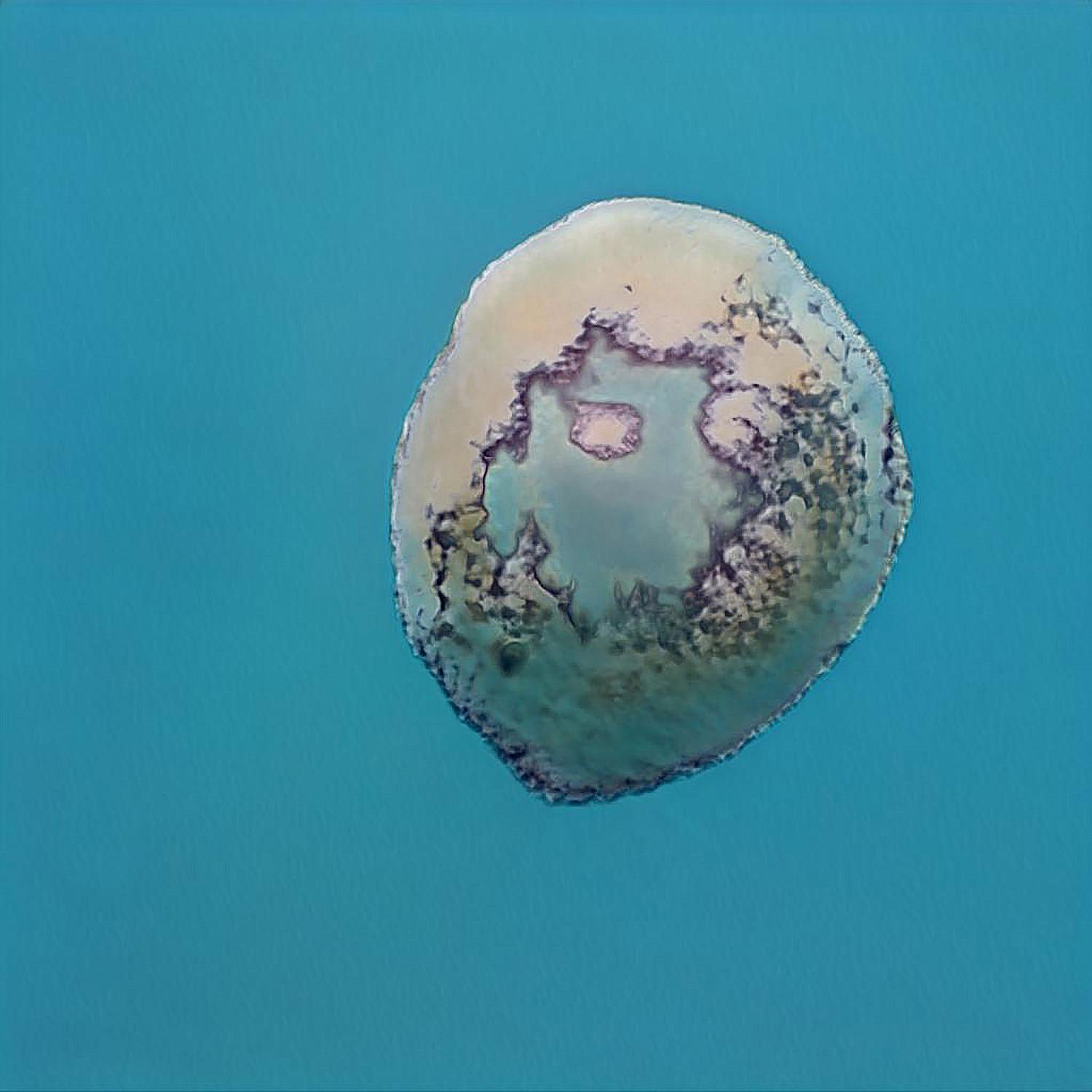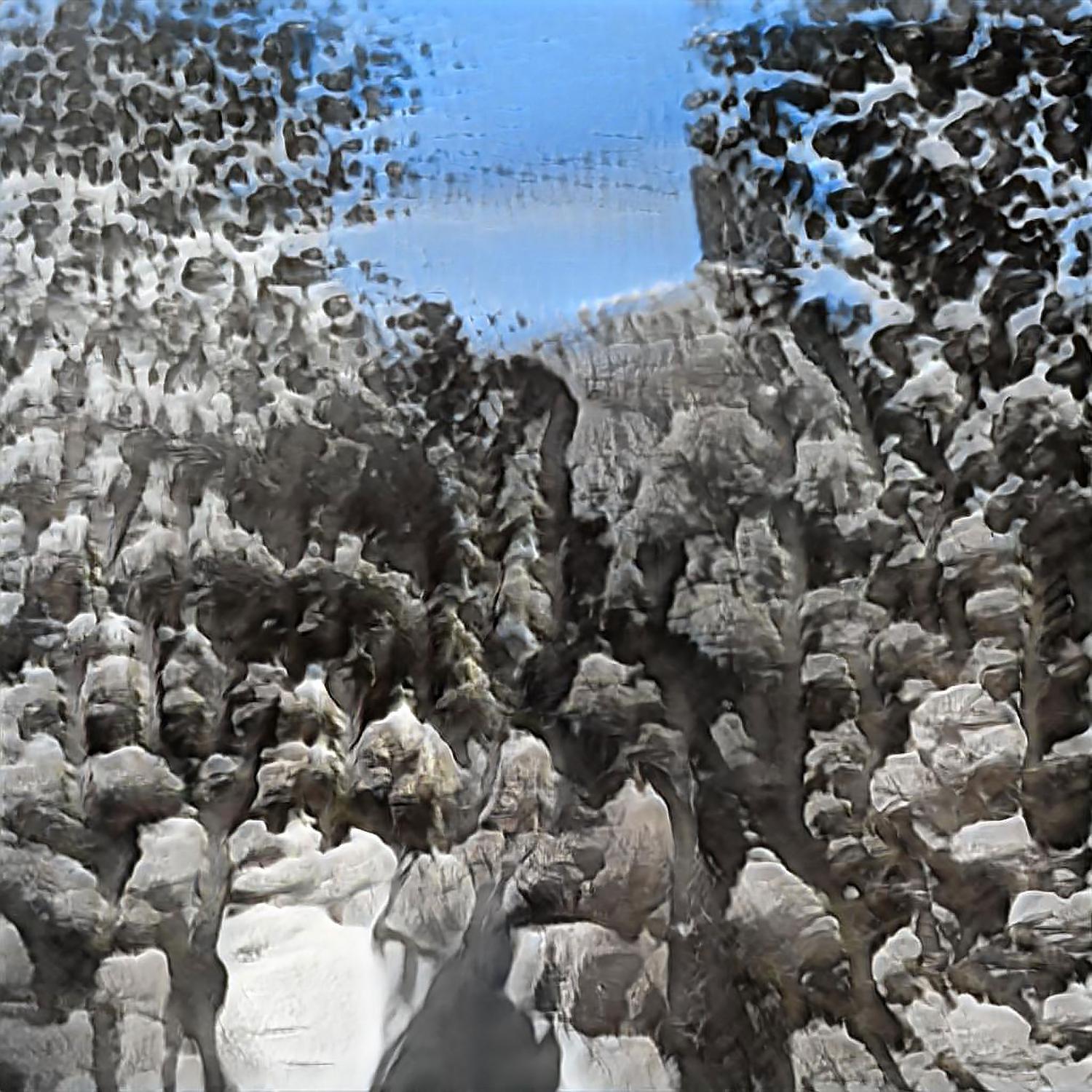ARTIST FOCUS: BETH COLEMAN
Learn about artist, composer and new media scholar Beth Coleman's work on technology and society, inspired by science-fiction writer Octavia Butler’s efforts to build kinship and make relations in her novels.
Video Duration: 9 min 22 sec (clip begins 0:56, ends 10:18)
Total Time for Activity: 60 to 90 minutes

Beth Coleman, Nikanji, from the series Oceanic, generated with Octavia Butler Artificial Intelligence (OBAI), 2023.
In Beth Coleman's Octavia Butler Artificial Intelligence (OBAI), the artist-researcher creates an AI model that helps her generate what she calls "boundary images" or figures that blend radical collective action among human bodies with landscape; the black feminine with the non-human; the oceanic with the extra-terrestrial.
What is Octavia Butler AI (OBAI)?
My Octavia Butler AI (OBAI) design takes as its point of departure the concept of Xenogenesis [the production of an offspring that is unlike either of its parents], particularly the origin story in the first book [in Butler’s Xenogenesis series], Dawn.
This origin narrative places Lilith Iyapo, a Nigerian-American West Coaster, as the pre-Eve progenitor of beyond human race in a near future where the genetic merger with an “alien” race is the only path to survival. This occurs after humans have environmentally destroyed the earth, obviously.
Lilith becomes the first human parent of an Oankali-human offsprint. It’s the negotiation of moving from horror to kinship that characterizes her transformation.- Beth Coleman in interview with Etienne Turpin, 2023.
Watch & Learn
This short presentation by artist Beth Coleman discusses her work with OBAI carried out in a six-month research fellowship at the University of Toronto.
Beth Coleman, “Reality Was Whatever Happened: Octavia Butler AI and Other Possible Worlds,” Jackman Humanities Institute, University of Toronto, Toronto, Canada. December 6, 2023.
QUESTION
In the video lecture, Coleman says she’s interested in using writer Octavia Butler’s methods to make relations with machines through Artificial Intelligence. She describes the Alice series as "portraits of a blended boundary, a black feminine figure in relation to something else: animal, alien, decidedly non-human, like Lilith Iyapo, the pre-Eve progenitor of a beyond human race." The Oceanic series takes the underwater environment as an input for portraiture. As she explains, "the configuration of kinship drifts further from the singularly human" (Coleman 2023, n.pag.)
- What do you think that Coleman means by ‘make relations’ with machines?
REFLECTION
Consider the following quote from Coleman in interview with philosopher and design researcher Etienne Turpin:
My focus was on boundary objects, things that open the doors between assumed categorical distinctions. (...) I am trying to ask how we might reconfigure kinship across strange relations. My engagement is meant to make AI more wild, not less. By “wild”, I indicate generative possibility for the technology in opposition to the reproduction of the same (Coleman 2023, n.pag.).
In your own words, describe what a ‘boundary object’ is. Give an example of your own.
Thinking back to Octavia Butler and Gwendolyn Brooks's poetic descriptions of different kinds of "echo-makers" in the previous chapter, where do you think Coleman's "wild" AI aligns? Explain.
QUESTION
In the video lecture, Coleman describes how she worked with Generative Adversarial Networks (GANs), which were more prevalently used in machine learning for image generation before the recent diffusion models (Stable Diffusion, DALL-E and Midjourney). GANs were the first models capable of creating photorealistic images.
- What did Coleman explore with GANs?
- What does she say that AI helps us to think about?
- Describe the processes involved in her project.
REFLECTION
Consider the following quote from Coleman's 2021 article 'Technology of the Surround' published in the journal Catalyst:
I see in AI an ethos of the itinerant. This horizontal logic of exceeding itself in the sense of moving outside of its given ontological domain and toward unchartered territory (the wild, the swamp, the surround, the alien) offers an opening to other possibilities beyond the reinscription of technologies of the artificial that enact a violence of ordering (Coleman 2021, 3).
Do you remember what the term "ontology" means? To refresh your memory, go back to the first 'Concept Focus' chapter on ethics in this workbook. Use the definition provided there to determine what an "ontological domain" is.
What do you think Coleman intends by "an ethos of the itinerant"? Break down the phrase into its constituent parts. The word "ethos" refers to the guiding The term "itinerant" describes something or someone that moves from place to place, often alternating between working and wandering. How is this relevant to AI and its ontology?

Beth Coleman, Liberation School, from the series BPP, generated with Octavia Butler Artificial Intelligence (OBAI), 2023.
KEY TERM: GENERATIVE ADVERSARIAL NETWORKS
Generative Adversarial Networks (GANs) are deep-learning algorithms that use computational methods to modify existing digital images, or to generate entirely new images that can be photo-realistic, hybrid or completely abstract. GANs operate through interactions between two neural networks: a generator and a discriminator. They are called 'adversarial' because they work against each other. The generator creates new data while the discriminator evaluates it. Through this process, the generator improves its ability to generate data similar to that which it was trained on.
What’s deep learning? A type of machine learning based on artificial neural networks. They are called ‘artificial’ neural net- works because they are based on the biological study of the brain but they are a network of mathematical functions in ma- chine learning. The phrase ‘neural network’ is a metaphor.
What’s an algorithm? Artist and technologist Stephanie Dinkins uses a simple definition - it is “a sequence of instructions telling a computer what to do.” For example, she explains, an everyday algorithm would be the steps you take in brushing your teeth.
An algorithm has great value because it is something that is fed historic infor- mation to predict something.
SUMMARY: HOW DOES OBAI USE GANs?
In interview with Tarpin, Coleman describes the use of GANs in OBAI as follows:
GAN design took a generative model for unsupervised learning [Machine Learning from unlabeled data in which the model tries to identify patterns and relations with the data on its own] and twined it with an “adversarial” aspect or discriminator model.
The discriminator model classifies examples from the generator model as real (from training data) or fake (generated). When the discriminator is fooled by a “fake” image, the GAN as a network demonstrates it is effectively producing images that correctly replicate the training data.
The adversarial model technique of self-testing for best outcomes produced a benchmark shift in AI image generation: an effective GAN meant most realistic; best outcomes signaled photoreal products. (…) A sign of its success was the meme This Person Does Not Exist. (…)
With OBAI, the idea was to take a GAN engine in the opposite direction – to intentionally jailbreak it toward other ways, otherwise. Without pretending these are innocent images, one might see a different type of collusion. To seek escape from an echo chamber of representation in a drift toward kin among animals and landscapes is not to necessarily get outside of capture. (...) I am doing what I can to disrupt the machine and unmoor the realms of restraint, to refuse the frame of the imperial panorama that can only repeat its grid upon the world (...) to some colonial infinity (Coleman 2023, n.pag.).